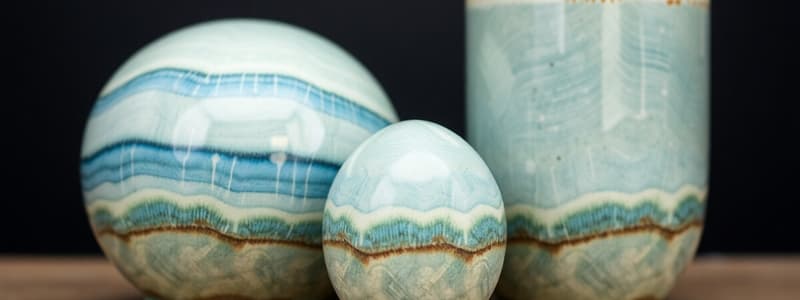Podcast
Questions and Answers
The Greek word 'Keramos' refers to potter's clay.
The Greek word 'Keramos' refers to potter's clay.
True (A)
Zirconium oxide is also known as alumina.
Zirconium oxide is also known as alumina.
False (B)
Glass ceramics have properties that are generally considered less desirable than those of conventional glasses.
Glass ceramics have properties that are generally considered less desirable than those of conventional glasses.
False (B)
E-type glass is known for offering higher strength and stiffness than S-type glass.
E-type glass is known for offering higher strength and stiffness than S-type glass.
Carbines are cutting tools made from ceramic materials.
Carbines are cutting tools made from ceramic materials.
Reinforced plastics are also known as polymer-matrix composites.
Reinforced plastics are also known as polymer-matrix composites.
The year 4000 B.C. marks the origin of creating bricks using straw and clay.
The year 4000 B.C. marks the origin of creating bricks using straw and clay.
Diamond is a form of carbon with a crystalline structure.
Diamond is a form of carbon with a crystalline structure.
Flashcards
Clay
Clay
A fine-grained, sheet-like material that forms the basis of many traditional and industrial ceramics.
Alumina
Alumina
A type of aluminum oxide used in ceramics, renowned for its high melting point and resistance to wear.
Sialon
Sialon
A material derived from silicon, aluminum, oxygen and nitrogen, known for its exceptional strength and heat resistance.
Nitrides
Nitrides
A ceramic material characterized by its extremely high hardness, often containing boron carbide.
Signup and view all the flashcards
Cermet
Cermet
A type of ceramic that combines ceramic and metallic properties, often used for high-temperature applications.
Signup and view all the flashcards
Glass
Glass
An amorphous solid, akin to a supercooled liquid, with a unique structure.
Signup and view all the flashcards
Glass Ceramics
Glass Ceramics
A type of ceramic characterized by a predominantly crystalline structure and desirable properties beyond typical glasses.
Signup and view all the flashcards
Reinforced Plastics
Reinforced Plastics
A type of composite material combining plastics and fibers, often used for lightweight constructions.
Signup and view all the flashcardsStudy Notes
Ceramics
- Ceramics are derived from the Greek words "keramos" (potter's clay) and "keramikos" (clay products).
- Traditional ceramics include whiteware, tiles, bricks, and sewer pipes.
- Industrial ceramics are used in engineering, high-tech, turbine, automotive, and aerospace components.
- Raw materials for ceramics include clay (fine-grained, sheet-like structure), kaolinite (from Kaoling hill in China), alumina (aluminum oxide), zirconia (zirconium oxide), carbides (cutting tools), nitrides, sialon (derived from Si, Al, O2, N2,), and cermets (black or hot-pressed ceramics).
- Ceramics are composed of silicates.
- Ceramics exhibit brittleness which is a property of strength and hardness.
- Glass is an amorphous solid with a structure like a liquid.
- Supercooled ceramics are cooled too quickly to form crystals, resulting in a non-crystalline structure.
- Ceramics are fabricated by heating materials to a molten or viscous state to produce useful items.
- Glass ceramics have a predominantly crystalline structure and desirable properties superior to glass.
Graphite
- Graphite is a crystalline form of carbon with a layered structure.
- The layers in graphite are bonded by weak forces allowing them to slide over each other.
- Basal planes are distinct layers in graphite.
- Diamond is another form of carbon with a covalently bonded structure.
Composites
- Composites are a combination of two or more chemically distinct materials.
- 4000 BCE, straw and clay were used to create bricks for construction.
- 1800s, steel reinforcing rods were combined with concrete for reinforced concrete structures.
- Reinforced plastics, also known as polymer matrix composites, comprise of a polymer matrix and reinforcing fibers.
Reinforced Plastics
- Hybrid materials involve more than one type of composite.
- Reinforcing fibers have high specific strength.
- The plastic matrix is less strong and less stiff.
- E-type glass is the most commonly used calcium aluminoborosilicate glass.
- S-type glass offers higher strength and stiffness but at higher cost.
- E-CR type glass exhibits higher resistance to elevated temperatures and acids.
Polymer Fibers
- Polymer fibers may contain nylon, rayon, acrylics, or aramids.
- Spectra is an ultra-high molecular weight fiber.
- Melt spinning involves extruding liquid polymer through holes in a die.
- Dry spinning involves dissolving the polymer into a liquid solution which creates a partially oriented liquid crystal form.
- Polymers can be fabricated into short or long fibers.
Carbon Fibers
- Carbon fibers are more expensive than glass fibers.
- Graphite fibers enhance electrical and thermal conductivity of reinforced plastic components.
- Ceramic fibers have low elongation, low thermal conductivity, and good chemical resistance.
Studying That Suits You
Use AI to generate personalized quizzes and flashcards to suit your learning preferences.




